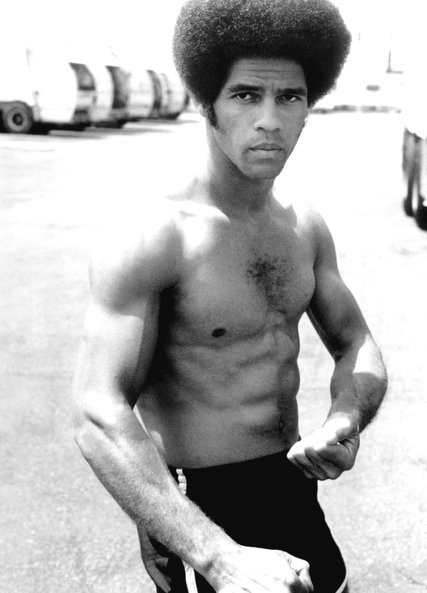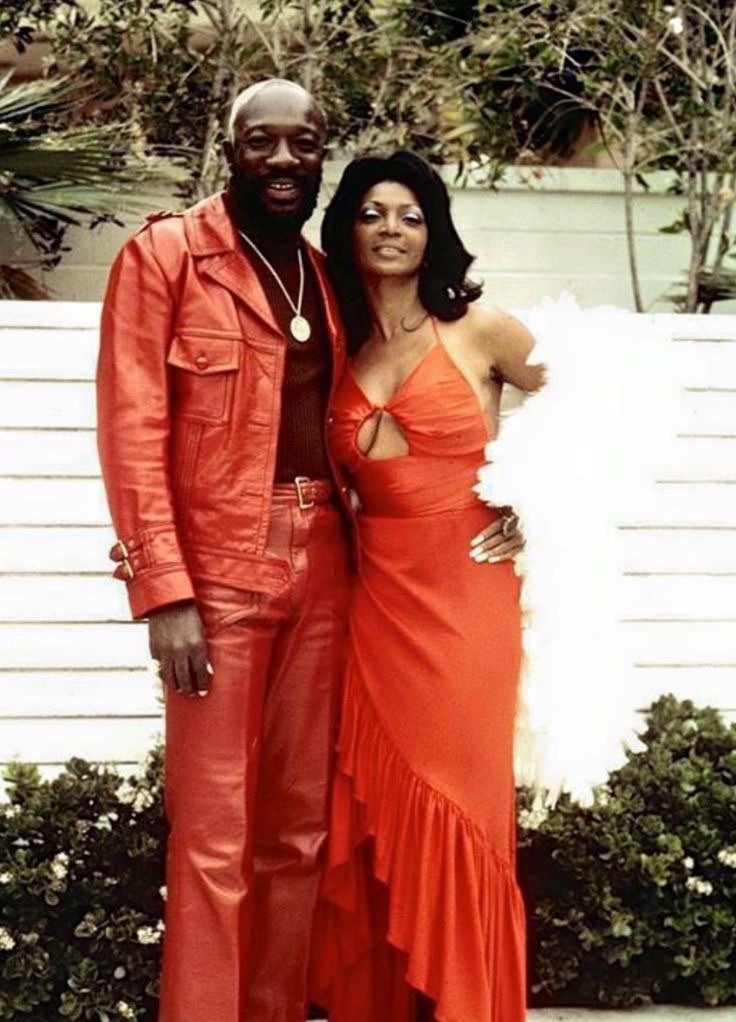Happy Friday POU! ![]()
Today we celebrate The Kings of Blaxploitation!
The New Leading Man
After World War II, pressure from black and white American groups and the Cold War rivalry between the United States and the Soviet Union for favorable world opinion made the integration of America a national priority. For Hollywood, desegregation meant the increased hiring of black actors, the creation of viable black characters instead of replicating stereotypes, and the production of serious films that addressed the issue of sustaining democratic values in a racist society. Films such as Blackboard Jungle (1955), The Defiant Ones (1958), and Pressure Point (1962) portray black men in complex social relationships with whites, in which they often assert themselves through moral or physical confrontation of racism—a first step in a new black cinema.
In the 1960s, the feature action film was integrated. A number of such feature films starred the former football great Jim Brown (Rio Concho, 1964; The Dirty Dozen, 1967; Ice Station Zebra, 1968;The Split, 1968; 100 Rifles, 1969; and Riot, 1969) with white stars such as Gene Hackman, Julie Harris, Rock Hudson, Lee Marvin, Burt Reynolds, and Raquel Welch. Brown’s virile, brooding presence reflected the growing influence of the Black Power movement upon mainstream culture and established the black rebel as a legitimate screen persona. Brown became the prototype of the black male action star. As such, he became even more prominent as a star in the action packed movies of the Blaxploitation genre.
However, even in the standard action movie of Hollywood, the black was almost certain to die. (See Jim Brown in “The Dirty Dozen.”) So it was powerful just for the lead character in Blaxploitation movies simply to make it to the end of the movie, as in “Sweetback.”
“We needed something to make us feel better about ourselves,” says Samuel L. Jackson, and the blaxploitation movies supplied that.
Jim Brown went on to star in the Blaxploitation hits Slaughter, Black Gunn, Slaughter’s Rip-off, The Slams and Three The Hard Way.
Trailer for Three The Hard Way – Fred Williamson, Jim Kelly and Jim Brown!
Richard Roundtree

Called “the first black action hero” for his portrayal of private detective John Shaft in the 1971 film Shaft, and its sequels, Shaft’s Big Score (1972) and Shaft in Africa (1973). For his performance in Shaft, Roundtree was nominated for the Golden Globe Award for New Star of the Year – Actor.
If the Shaft trilogy isn’t in your collection, make it happen!

Like many of the male stars of the era, Bernie Casey was a phenomenal athlete (explains all the fineness of these dudes, yes Lawd). Casey was a record-breaking track and field athlete for Bowling Green State University. As one of the nation’s best high-hurdlers, Casey earned All-American honors and a trip to the finals at the 1960 United States Olympic Trials. In addition to national honors, Bernie Casey won three consecutive Mid-American Conference titles in the high-hurdles, 1958–60.
Casey was drafted by the San Francisco 49ers in 1961 as the 9th pick in the first round. He played for eight NFL seasons: six with the 49ers and two with the Los Angeles Rams.
Blaxpoloitation filmography: …tick…tick…tick, Black Chariot, Black Gunn, Hit Man, Cleopatra Jones, Cornbread Earl and Me, Dr. Black Mr. Hyde
Legendary Fred Williamson is a former Pittsburgh Steeler, Kansas City Chief and Oakland Raider. He also has black belts in Kenpō, Shotokan karate and taekwondo. He became an actor much in the same mold as Jim Brown – the fierce black man that would take NO MESS. He has stated “I had three rules that Hollywood just wouldn’t adhere to: I’ve got to win the fights, you can’t kill me, and I’ve got to get the girl at the end of the movie. They weren’t going to let that happen, so I went to Europe.” When the Blaxploitation era began, he was a prime candidate for starring roles.
In October 1973, Williamson posed nude for Playgirl magazine, preempting Jim Brown’s appearance in 1974.
His Blaxploitation filmography includes: Hammer, The Legend of Nigger Charley, The Soul of Nigger Charley, Black Caeser, Hell up in Harlem, That Man Bolt, Three the Hard Way, Black Eye, Mean Johnny Barrows, Crazy Joe, Three Tough Guys, Bucktown, Take a Hard Ride, Boss Nigger (which he also produced).
Ron O’Neal

O’Neal gave us one of the most iconic characters from this era, Youngblood Priest, a New York cocaine dealer in the blaxploitation film Super Fly (1972) and its sequel Super Fly T.N.T. (1973). O’Neal was also a director and writer for the sequel.
By his own account, Rudy Ray Moore was working at a record store in Hollywood in 1970 when he began hearing obscene stories of “Dolemite” recounted by a local man named Rico. Moore began recording the stories, and assumed the role of “Dolemite” in his club act and on recordings. In 1970–71 he recorded three albums of material, Eat Out More Often, This Pussy Belongs To Me, and The Dirty Dozens, where “with jazz and R&B musicians playing in the background, [Moore] would recite raunchy, sexually explicit rhymes that often had to do with pimps, prostitutes, players, and hustlers.”
Moore was influenced by more mainstream comedians such as Red Foxx and Richard Pryor, as well as by traditions such as the Dozens. The recordings were usually made in Moore’s own house, with friends in attendance to give a party atmosphere. The album covers and contents were often too racy to be put on display in record stores and were sold under the counter, but the records became popular through word of mouth and were highly successful in disadvantaged black American communities, where his “warped wit and anti-establishment outlook” were embraced.
Moore spent most of his earnings from the records to finance the movie Dolemite, which appeared in 1975 and has been described as “one of the great blaxploitation movies” of the 1970. The character was “the ultimate ghetto hero: a bad dude, profane, skilled at kung-fu, dressed to kill and hell-bent on protecting the community from evil menaces. He was a pimp with a kung-fu-fighting clique of prostitutes and he was known for his sexual prowess.”
The film was successful and was followed by sequels, The Human Tornado, The Monkey Hustle, and Petey Wheatstraw: The Devil’s Son-in-Law. Moore continued to release albums that appealed to his enduring fanbase through the 1970s and 1980s, but little of his work reached the mainstream white audience. His “rapid-fire rhyming salaciousness exceeded the wildest excesses” of Foxx and Pryor, and his highly explicit style kept him off television and major films. At the same time, Moore often spoke in his church and regularly took his mother to the National Baptist Convention. He said that: “I wasn’t saying dirty words just to say them… It was a form of art, sketches in which I developed ghetto characters who cursed. I don’t want to be referred to as a dirty old man, rather a ghetto expressionist.“
Jim Kelly

Jim Kelly, another great athlete, began his athletic career at Bourbon County High School in Paris, KY, competing in basketball, football and track and field. He attended the University of Louisville, where he played football, but left during his freshman year to begin studying Shorin-ryu karate.
Kelly began his martial arts career under the tutelage of Sin Kwan The (Shaolin-Do) in Lexington, KY. There he trained in Okinawan karate. During the early 1970s, Jim Kelly became one of the most decorated world karate champions in the sport. In 1971, Kelly won four prestigious championships that same year, most notably, the World Middleweight Karate title at the 1971 Long Beach International Karate Championships. He opened his own dojo, which was frequented by numerous Hollywood celebrities.
Kelly became the first Black martial arts film star. He co-starred alongside Bruce Lee in the blockbuster, Enter the Dragon(1973) in a role originally intended for actor Rockne Tarkington, who unexpectedly dropped out days before shooting in Hong Kong. Producer Fred Weintraub had heard about Kelly’s karate studio in the Crenshaw district of Los Angeles, went there to see him, and was immediately impressed.
This appearance led to starring roles in a string of martial arts-themed blaxploitation films, among them Melinda (1972), and Black Belt Jones (1974). This was the only role in which he was the primary star; most of Kelly’s film roles played up the novelty of an African American martial arts master. He earned a three-film contract with Warner Brothers and made Three the Hard Way (1974) with Jim Brown and Fred Williamson, and Hot Potato (1976), in which he rescues a diplomat’s daughter from the jungles of Thailand.
Bonus Clip!
Although Isaac Hayes and Nichelle Nichols were actually only in one true Blaxploitation film, it was a good one!

Check out this clip of them from Truck Turner!





